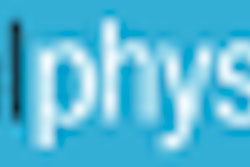
Immuno-PET is a nuclear medicine technique that combines the high sensitivity and resolution of PET with the specificity of a monoclonal antibody (mAb). The PET tracer zirconium-89 (Zr-89) is under increased interest for immuno-PET imaging, as its long physical half-life matches the pharmacokinetics of antibodies and it can be produced using medical cyclotrons.
 Nikolaos Makris from the VU University Medical Center Department of Radiology and Nuclear Medicine.
Nikolaos Makris from the VU University Medical Center Department of Radiology and Nuclear Medicine.Immuno-PET requires development of dosimetric methods that provide accurate estimates of organ absorbed dose. Such dosimetry usually involves manual delineation of volumes-of-interest (VOI) in the CT scan, then mapping these volumes onto the corresponding PET scans. To ease this process, researchers from the VU University Medical Center in Amsterdam have developed a semiautomatic, accurate VOI delineation method that is significantly faster than manual delineation (Medical Physics, October 2014, Vol. 41:10, pp. 102503-1 to 102503-9).
"Radiation dosimetry relates the injected amount of radiolabeled compound to the absorbed radiation dose in organs, tumors, and the entire body. Manual delineation of VOIs is very time-consuming. More automated dosimetry approaches are needed to determine organ absorbed and effective doses," explained lead author Nikolaos Makris, a doctoral student. "For our study, we developed and evaluated simplified dosimetry approaches that would guarantee accurate localization of delineated organ VOIs and subsequent quantification of organ absorbed doses."
Zirconium-89 advantages
Immuno-PET imaging has the ability to visualize and characterize tumor lesions, as well as identify patients who can benefit from mAb treatment and monitor the progress of patients receiving this treatment. As a result of improvements in PET system design, and advancing development and availability of antibody-based molecules, immuno-PET is increasingly being applied in the diagnosis and treatment of cancer patients.
The technology is based on annihilation coincidence detection after labeling of a mAb or mAb fragment with a positron-emitting radionuclide. After injection into a patient, the radioisotope emits a positron that, after traveling a specific distance and having lost its kinetic energy, will annihilate with a nearby electron, emitting two antiparallel 511-keV gamma ray photons. These will be detected by a PET camera.
In a review article discussing the applications of Zr-89-labelled antibodies, Floor van de Watering of Radboud University Medical Center in the Netherlands and co-authors describe other advantages of Zr-89 (BioMed Research International, 28 May 2014).
These include the following:
- A relatively low average positron energy of 395 keV, ideal for high-resolution PET of slow-accumulating biomolecules.
- Being safer to handle and more stable in vivo than iodine-124 (I-124)-based agents for clinical applications.
- Zr-89-based PET scans offer more straightforward reconstruction to attain good image quality compared with I-124.
The long half-life of Zr-89 -- 78.4 hours -- also provides ample time for production, administration, and patient uptake of the tagged radiopharmaceutical. Another advantage is that the nuclides will remain in the tumor cells after the mAbs are catabolized, so time series studies are possible without incurring further administration of radiopharmaceuticals (Radiation Physics and Chemistry, November 2014, Vol. 104, pp. 145-149).
Delineation comparisons
To test their simplified dosimetry approach, Makris and colleagues worked with images of five patients with advanced colorectal cancer, who each had five PET/CT scans taken one to 144 hours after administration of a therapeutic dose of 500 mg/m2 cetuximab. For reference, the researchers manually delineated VOIs in lungs, liver, spleen, and kidneys on all five CT scans of each patient.
Organ activity was determined by mapping the CT VOI onto the correspondingly resampled PET scans. The total activity for each organ was then determined using in-house developed software. For each patient, they calculated the average percentage changes in total organ activity and absorbed dose between the reference manual VOI delineation and five different semi-automated VOI delineation methods, plus simplified (using larger voxel sizes) manual delineations.
In general, deformable registration (nonrigid, rigid prior to nonrigid, and affine prior to nonrigid) performed better than rigid and affine registration strategies. Semiautomatic delineation based on nonrigid registration showed excellent agreement for lungs and liver, and good agreement for spleen and kidneys using the Dice similarity coefficient (DSC). Hausdorff distance (the maximum distance needed to move the boundaries of the fixed region to completely overlap with the registered region) ranged from 13 mm to 16 mm, depending on the organ.
Organ absorbed dose and total activity based on nonrigid registration were within 10% of the reference values. By comparison, these ranged from -5% to +94% for the manual delineation methods, depending on organ and voxel size. For kidneys and spleen, as voxel size increased, the accuracy in total activity and absorbed dose decreased. The effective dose was within 3% for all VOI delineation methods.
The time savings offered by semiautomatic delineation based on nonrigid registration were significant. Manual delineation took an average of five hours per patient to draw 20 VOIs, according to Makris, whereas the semiautomatic method was seven times faster.
The research team has created an easy-to-use image processing tool that provides clinicians with a fast and accurate way to derive organ absorbed dose and effective dose estimates, Makris told medicalphysicsweb. "Predefined VOI templates tailored to patient body size can be used to further diminish the time required for VOI delineation," he added. "Although this will be a challenging task, as it will be required to bring imaging features from different patients into alignment, it will obviate the need for time-consuming manual VOI delineation." The researchers are now working on this.
© IOP Publishing Limited. Republished with permission from medicalphysicsweb, a community website covering fundamental research and emerging technologies in medical imaging and radiation therapy.



















